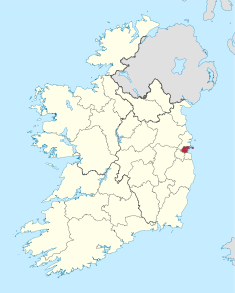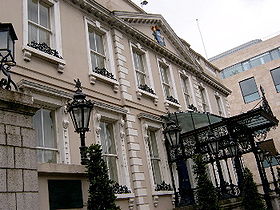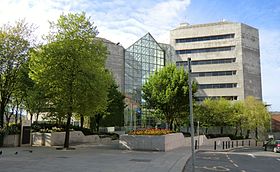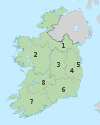- Dublin City Council
-
Dublin City Council
Comhairle Cathrach
Bhaile Átha Cliath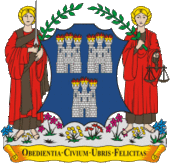
Type Type City council Leadership Lord Mayor Andrew Montague,
Labour PartyMembers 52 Political groups Labour Party (19)
Fine Gael (12)
Fianna Fáil (6)
Sinn Féin (5)
PBPA (2)
Éirígí (1)
Independents (7)Elections Last election 5 June 2009 Meeting place 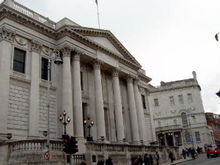
Dublin City Hall Website www.dublincity.ie Dublin City Council (Irish: Comhairle Cathrach Bhaile Átha Cliath) is the local authority for the city of Dublin in Ireland. It has 52 members and is the largest local authority in Ireland. Until 2001, it was known as Dublin Corporation.
Contents
Legal status
As part of the Dublin Region, Dublin City Council is within the geographic remit of the Dublin Regional Authority. Following the enactment of the Local Government Act 2001, the Regional Authority was established.[1] It is one of eight such Authorities in the state. Local government in the region was further regulated by the Local Government Act 1994. This provided for the legal establishment of the following local government administrative areas:
- Fingal
- South Dublin
- Dun Laoghaire-Rathdown
and also recognised the extant Dublin Corporation area, vesting its powers in a renamed entity – Dublin City Council. The statutory instrument giving effect to the Act came into force on 1 January 1994.[2] The instrument also provided for the abolition of Dublin County Council – the entity that had proviously had responsibility for Dun Laoghaire-Rathdown, Fingal and South Dublin. The four entities collectively comprise the former entity known as County Dublin. This entity, which had been created after the Norman invasion of Ireland, was abolished under the Acts.
Statutory functions
The functions of the City Council include: Public Housing, Library Services, Refuse Services, Drainage, Driver and Vehicle Licencing, Planning and Roads. The Council budgeted to spend €847,137,522 during 2007 in service of these functions. 50.5% of this went towards the payroll of the Council's staff which was a reduction from 50.7% in 2006. In the case of Traffic Management, the Council receives grants from the Department of Environment, Heritage and Local Government and also the National Roads Authority to assist it in meeting this responsibility. The 2007 roads budget was just over €105,000,000, to support maintenance of all roads in its functional area.
History
From 1841 until 1 January 2002 it referred to the unicameral city assembly of Dublin, which was part of the overall administrative and governmental system of Dublin known as Dublin Corporation. Since 1 January 2002, it is the name which applies both to the assembly and to the whole system of Dublin government formerly called Dublin Corporation.[3]
The Assembly
Under the Municipal Corporations (Ireland) Act 1840, the previous bicameral assembly of a House of Aldermen and a House of Sheriffs and Commons was replaced by a unicameral assembly. The new name Dublin City Council was coined for the unicameral assembly. It was presided over by the Lord Mayor of Dublin, the first citizen of the city, an office which had existed since 1665. The first City Council was elected in October 1841, and Daniel O'Connell became the first Lord Mayor under the new system.
The Corporation becomes the Council
At the start of the 21st century the Minister for the Environment and Local Government, Noel Dempsey made changes to Irish local government. Dublin City Council was established at the same time that Dublin County Council and the Corporation of Dún Laoghaire were abolished[4] in 1994, by an Act of the Oireachtas, the Local Government (Dublin) Act, 1993. Some citizens still use the name "Dublin Corporation" when referring to the Council. The Act also abolished the title Alderman. To coincide with its name change, the City Council adopted a new logo and brand identity, based on a simplified version of the ancient "three castles" symbol.
Structures
Executive power is shared between the council and an appointed executive official known as the Manager.
City Manager
The Dublin City Manager is the chief executive officer the council. The Manager is responsible for a staff of 6,200. The offices of the Manager and other administrative staff are based in the Civic Offices on Wood Quay.
The Lord Mayor
The Lord Mayor of Dublin performs two distinct functions. He or she is chair of the Council, and symbolic and ceremonial head of the city government.
Assembly
While also referring to the overall city government, Dublin City Council also refers to the city assembly. That assembly is made up of 52 members. Members are elected using Proportional representation using the Single transferable vote, every five years from Dublin City Council Local electoral areas. The party or group of parties which win the majority of seats control the City Council agenda, deciding who sits on what committee, what policies are followed, and who becomes the Lord Mayor. The City Council meets in plenary session on the first Monday of every month in Dublin City Hall. One of the Council's most important roles is that of passing an annual budget. Should any Irish council fail to pass a budget within the allotted time, the Minister for the Environment is empowered to abolish it and grant its powers to a commissioner until the next scheduled council elections.
Elections
The Council currently consists of:
Party Seats Labour Party 19† Fine Gael 12 Fianna Fáil 6 Sinn Féin 5† People Before Profit Alliance 2 Éirígí 1† Independents 7† †Nineteen Labour, seven Sinn Féin and six Independent councillors were elected in the 2009 local elections. However, two Sinn Féin Councillors, Christy Burke and Louise Minihan, resigned from the party in 2009 with Burke sitting on the council as an independent and Minihan joining Éirígí, and a third, Killian Forde, resigned in January 2010 to join the Labour Party. Following Forde's resignation from the council, the seat reverted to Sinn Féin.[5]
Local electoral areas
The city is divided into 11 Local electoral areas each of which elects between 4–6 councillors. The electoral areas used for the last local elections were:
Area Seats Artane–Whitehall 5 Ballyfermot–Drimnagh 4 Ballymun–Finglas 5 Cabra–Glasnevin 5 Clontarf 5 Crumlin–Kimmage 4 Donaghmede 4 North Inner City 6 Pembroke–Rathmines 6 South East Inner City 4 South West Inner City 4 Dublin City Council must by law at least once in every ten years, following consultation with the returning officer for Dáil elections in respect of each constituency within its area, establish a polling district containing a polling place. This is call the Polling Scheme which lists each constituency with its Local electoral areas, polling districts and polling places.
Councillors by electoral area
This list reflects the order in which councillors were elected on 5 June 2009.
†Replaced during term, see table below for details. ‡Changed party, see last table for details.
Co-options
Outgoing Party Electoral area Reason Date Co-optee Party Maureen O'Sullivan Independent North Inner City Elected to Dáil Éireann at the Dublin Central by-election June 2009 Marie Metcalfe Independent Killian Forde Labour Party Donaghmede Resigned from the council February 2011 Mícheál Mac Donncha Sinn Féin Michael Conaghan Labour Party Ballyfermot–Drimnagh Elected to Dáil Éireann at the 2011 general election February 2011 Shelia Howes Labour Party John Lyons Labour Party Ballymun–Finglas Elected to Dáil Éireann at the 2011 general election February 2011 Steve Wren Labour Party Dessie Ellis Sinn Féin Ballymun–Finglas Elected to Dáil Éireann at the 2011 general election February 2011 Anthony Connaghan Sinn Féin Aodhán Ó Ríordáin Labour Party Clontarf Elected to Dáil Éireann at the 2011 general election February 2011 Jane Horgan-Jones Labour Party Eric Byrne Labour Party Crumlin–Kimmage Elected to Dáil Éireann at the 2011 general election February 2011 Michael O'Sullivan Labour Party Joan Collins PBPA Crumlin–Kimmage Elected to Dáil Éireann at the 2011 general election February 2011 Pat Dunne PBPA Seán Kenny Labour Party Donaghmede Elected to Dáil Éireann at the 2011 general election February 2011 Brian McDowell Labour Party Eoghan Murphy Fine Gael Pembroke–Rathmines Elected to Dáil Éireann at the 2011 general election February 2011 Paddy McCartan Fine Gael Kevin Humphreys Labour Party South East Inner City Elected to Dáil Éireann at the 2011 general election February 2011 Gerry Ashe Labour Party Catherine Noone Fine Gael South East Inner City Elected to Seanad Éireann April 2011 Kieran Binchy Fine Gael Changes in affiliation
Name Electoral area Elected as New affiliation Date Christy Burke North Inner City Sinn Féin Independent June 2009 Louis Minihan Ballyfermot-Drimnagh Sinn Féin Éirígí June 2009 Killian Forde Donaghmede Sinn Féin Labour Party January 2010 Council buildings
Mansion House
The Lord Mayor's official residence is the Mansion House, which first became the residence of the Lord Mayor in 1715.
Dublin City Hall
Council meetings take place in the headquarters at Dublin City Hall. Formerly Royal Exchange, the City Hall is one of Dublin's finest buildings and located on Dame Street. It was built in 1769–79 to the winning design of Thomas Cooley. In an architectural competition, James Gandon was the runner-up with a scheme that many people favoured. The building was taken over for city government use in the 1850s.
Civic Offices
Much of the council's administrative staff are based in the Civic Offices on Wood Quay. These offices were built in 1979–80 on top of what had been one of the best preserved Viking sites in the world. The Corporation's (as it was then) decision to bulldoze the historic site proved one of the most controversial in modern Irish history, with thousands of people, including medieval historian Fr. F. X. Martin and Senator Mary Robinson (later President of Ireland) marching to try to stop the destruction. The destruction of the site on Wood Quay and the building of a set of offices known as The Bunkers (being a prime example of Brutalist architecture) is generally seen as one of the most disastrous acts against Ireland's heritage since independence, with even Dublin Corporation admitting subsequently that it was ashamed of its action. Originally, there were to be four of these 'bunkers' built but only two were ever completed. Instead the river frontage is a block designed by the firm Scott Tallon Walker. Completed in 1994, it boasts a leafy atrium and fine views from many of its offices.
See also
External links
- Dublin City Council website
- Full list of Councillors
- Local Government Act, 2001
- History of Dublin City Council
References
- ^ (Regional Authorities) Establishment Order 1993.
- ^ Local Government (Dublin) Act, 1993:
Section 2: "the county", in relation to any time before the establishment day, means the administrative county of Dublin
Section 9(1) On the establishment day— ... (a) the county shall cease to exist. - ^ According to the "Local Government Act, 2001", section 10(2): "The State continues to stand divided into local government areas to be known as counties and cities which are the areas set out in Parts 1 and 2, respectively, of Schedule 5.".
- ^ "Local Government (Dublin) Act, 1993, Section 9.—(1)". Irish Statute Book. http://www.irishstatutebook.ie/1993/en/act/pub/0031/print.html#sec7. Retrieved 22 July 2011.
- ^ "Sinn Fein to reclaim Forde's council seat". Dublin People. 15 March 2011. http://www.dublinpeople.com/content/view/4402/57/.
Local administrative units of Ireland Border Region - Cavan County Council
- Donegal County Council
- Leitrim County Council
- Louth County Council
- Monaghan County Council
- Sligo County Council
West Region - Galway City Council
- Galway County Council
- Mayo County Council
- Roscommon County Council
Midlands Region - Laois County Council
- Longford County Council
- Offaly County Council
- Westmeath County Council
Mid-East Region - Meath County Council
- Kildare County Council
- Wicklow County Council
Dublin Region - Fingal County Council
- Dublin City Council
- Dún Laoghaire-Rathdown County Council
- South Dublin County Council
South-East Region - Carlow County Council
- Kilkenny County Council
- South Tipperary County Council
- Waterford City Council
- Waterford County Council
- Wexford County Council
South-West Region - Cork City Council
- Cork County Council
- Kerry County Council
Mid-West Region - Clare County Council
- Limerick City Council
- Limerick County Council
- North Tipperary County Council
Categories:- Local government in County Dublin
- History of Dublin (city)
- Government by city
- LAU-1 authorities in the Republic of Ireland
- 1841 establishments in Ireland
- Politics of Dublin (city)
Wikimedia Foundation. 2010.

